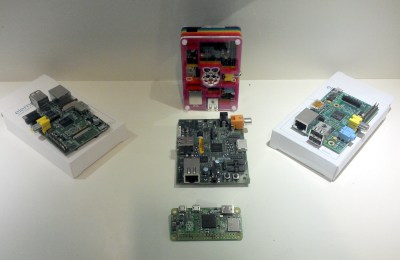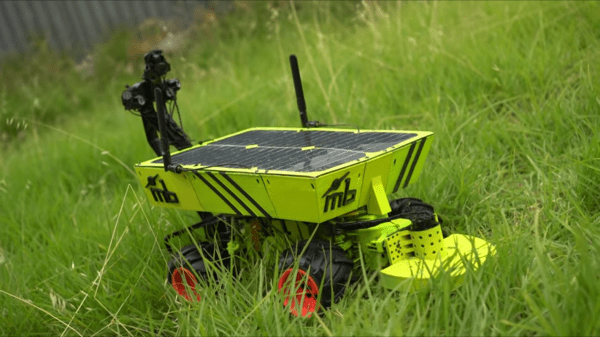Newton famously said, “If I see further than others, it is by standing upon the shoulders of giants.” For 3D printing, though, it might be the reverse. If a printer prints larger than others, it is probably using work developed for smaller printers. There are a variety of very large 3D printers out there now and you frequently see claims in the press of “world’s largest 3D printer.” Roboze, for example, makes that claim with a build volume of 1 meter on each axis.
Logic Simulation Hack Chat With Al Williams
Join us on Wednesday, March 2 at noon Pacific for the Logic Simulation Hack Chat with Al Williams!
Many of us probably remember — some fondly, some less so — our first encounter with a truth table. The little grid of ones and zeros seemed simple enough, but it held real power in its tabular representation of the output of a logic circuit for a given set of inputs. It’s what makes more complex logic circuits possible, but only up to a point — add enough gates, flip flops, and counters, and keeping track of what’s high and what’s low becomes problematic with just pencil and paper.
If you’ve reached the point where keeping your digital design in your head doesn’t work anymore, or if you never could keep your NANDs and NORs straight, then you’re ready for a digital logic simulator. Applications like Falstad and LogiSim let you build a design using everything from discrete logic gates to complete assemblies like adders, counters, and even arithmetic logic units. Add in some passives like capacitors and inductors, and a logic simulator may be the only tool you need to bring a design to life in the virtual world before ever touching a breadboard.
 To help us figure out where logic simulators fit in our design processes, Hackaday Staff Writer Al Williams will hop onto the Hack Chat with us. Al ran a very successful FPGA Bootcamp series back in 2018, which included a review of digital logic using Falstad. He’ll expand on that in this Hack Chat, so come along with your questions and comments. You won’t want to miss this one!
To help us figure out where logic simulators fit in our design processes, Hackaday Staff Writer Al Williams will hop onto the Hack Chat with us. Al ran a very successful FPGA Bootcamp series back in 2018, which included a review of digital logic using Falstad. He’ll expand on that in this Hack Chat, so come along with your questions and comments. You won’t want to miss this one!
Our Hack Chats are live community events in the Hackaday.io Hack Chat group messaging. This week we’ll be sitting down on Wednesday, March 2 at 12:00 PM Pacific time. If time zones have you tied up, we have a handy time zone converter.
Continue reading “Logic Simulation Hack Chat With Al Williams”
Boring Belt Sander Is RC Racer In Disguise
As a child, [David Windestal] already knew that a belt sander was the perfect motor for a banging radio-controlled car. Many years later, the realization of that dream is everything he could have hoped for.
The core of this project is a battery-powered belt sander by a well known manufacturer of gnarly yellow power tools. With an eye for using bespoke 3D printed parts, the conversion appeared straightforward – slap on (or snap on) a pre-loved steering mechanism, add a servo for controlling the sander’s trigger, and that’s pretty much job done. Naturally the intention was to use sandpaper as tread, which is acceptable for outdoor use but not exactly ideal for indoors. A thermoplastic polyurethane (TPU) tread was designed and printed for playtime on the living room floor, where sandpaper may be frowned upon.
The finished product is a mean looking toy with plenty of power. What we really like most about this hack is the commitment to the aesthetics. It’s seriously impressive to see a belt sander so convincingly transformed into a three-wheeler radio-controlled car. The final iteration is also completely reversible, meaning that your belt sander can keep on sanding two by fours on the job site. All the printed parts snap snug into place and are mostly indistinguishable from the stock sander.
Speaking of reversible, there were just a couple of issues with the initial design, if you catch our drift. We won’t spoil what happens, but make sure to watch the video after the break for the full story.
If this hack has whet your appetite for more quirky tool hacks, make sure to check out our coverage of the angle grinder turned slimline belt sander. Or if you can’t get enough of RC, then check out this remote controlled car with active suspension.
Continue reading “Boring Belt Sander Is RC Racer In Disguise”
It’s Official! The Raspberry Pi Is Now 10!
In any given field there are epoch-defining moments, those events after which nothing was quite the same as it had been before. It’s been a decade since the launch of the first Raspberry Pi single board computer. This was by no means the first inexpensive computer board, nor was it the first to support the GNU/Linux operating system, but it was among the first to promise a combination of those two. Coupled with support from a crop of British 8-bit alumni meant that from when it first gained publicity in early 2011 it garnered a huge buildup of interest.
We were first teased with a USB stick style prototype, which morphed into a much larger Raspberry Pi alpha board and finally into pre-production boards much closer to the model launched at the end of February ten years ago.
How To Disappoint Every Single British Geek At 6 AM

Pedants will claim that the 10th birthday of the Pi is technically not yet upon us because those first Model B boards went on sale on the 29th of February 2012, a leap day. The two distributors, RS and Farnell, were both putting them on sale with the expectation of selling around 10,000 units — a prediction that proved woefully inadequate, with both websites collapsing under the weight of would-be Pi-purchasers within seconds of opening up at 6 AM.
I was ready to order at 6 AM, and was only able to order mine halfway through the day. That short wait would be just the beginning — because they received so many more orders than anticipated, the bulk of the orders weren’t fulfilled until May. Nobody had imagined how wildly successful the Pi boards would become. Continue reading “It’s Official! The Raspberry Pi Is Now 10!”
Autonomous Mower Hits Snag
Interfacing technology and electronics with the real world is often fairly tricky. Complexity and edge cases work their way in to every corner of a project like this; just ask anyone who has ever tried to operate a rover on Mars, make a hydroponics garden, or build almost any robotics project. Even those of us who simply own a consumer-grade printer are flummoxed by the ways in which they can fail when manipulating single sheets of paper. This robotic lawnmower is no exception, driving its creator [TK] to extremes to get it to mow his lawn.
[TK] actually had a platform for his autonomous mower ready to go thanks to a previous build using this solar-powered robot to explore the Australian outback. Adding another motor to handle the grass trimming seemed simple at first and he set about wiring it all up and interfacing it to the robot. After the first iteration he found the robot was moving too fast to effectively cut the grass, so he added a more powerful cutting motor and a gearbox to help the mower crawl more slowly over the lawn. Disaster struck when his 3D printed mount for the steel cutting blades shattered, but with [TK] uninjured he pushed on with more improvements.
As it stands right now, the mower can effectively cut the grass moving forward even with the plastic-only cutting blades that [TK] is using now for safety reasons. The mower stripped its reverse gear so there still are some improvements to make before this robot is autonomously cutting the lawn without supervision. Normally we see lawnmowers retrofitted with robotics rather than robotics retrofitted with a lawnmower, but we’re excited to see any approach that lets us worry about one less household chore.
Thanks to [Rob] for the tip!
Mask Sanitization That Anyone Can Build
We’ve seen a wide variety of mask sanitization solutions, and now, [spiritplumber] from [Robots Everywhere] brings us a frugal and ingenious design – one that you barely even need tools for. This project might look rough around the edges but looks were never a prerequisite, and as a hacker worth their salt will recognize – this is an answer to “how to design a mask disinfector that anyone can build”.
Local shortages of masks have been threatening communities here and there, doubly so if you need a specific kind of mask that might be out of stock. This design could apply to a whole lot of other things where sterilization is desired, too – improving upon concepts, after all, is our favourite pastime.
The design is simple – a battery-powered motor rotating a mask inside a vat of concentrated H2O2, turned into mist by a cheap ultrasonic misting gadget. As the “turntable” rotates a your PPE of choice, making sure that every crevice is graced with cleaning touch of peroxide, it also causes the H2O2 mist to circulate. Fulfilling most important requirements for a proper sanitization system that more complex devices have been struggling with, this approach has certainly earned its place under the sun.
[Robots Everywhere] have shared a small library of their DIY PPE resources with all of us, and that’s not all they work on – recently, we’ve seen their aeroponics project rejuvenating garlic.
Using hydrogen peroxide vapour for PPE sanitization is a well-tested approach by now, as we’ve seen it deployed back in 2020 on a larger scale as part of an FDA-approved design. And if you only have 3% peroxide at hand, might as well try concentrating it further!
Simple DRAM Tester Built With Spare Parts
Some of the most popular vintage computers are now more than forty years old, and their memory just ain’t how it used to be. Identifying bad memory chips can quickly become a chore, so [Jan Beta] spent some time putting together a cheap DRAM tester out of spare parts.
This little tester can be used with 4164 and 41256 DRAM memory chips. 4164 DRAM was used in several popular home computers throughout the 1970s and 1980s, including the Apple ][ series, Commodore 64, ZX Spectrum and many more. Likewise, the 41256 was used in the Commodore Amiga. These computers are incredibly popular in the vintage computing community, and its not uncommon to find bad memory in any of them.
With an Arduino at its core, this DRAM tester uses the most basic of electronic components, and any modest tinkerer should have pretty much everything in stock. The original project can be found here, including the Arduino code. Just pop the suspect chip into the ZIF socket, hit the reset switch, and wait for the LED – green is good, and red means it’s toast.
It’s a great sanity check for when you’re neck deep in suspect DRAM. A failed test is a sure sign that the chip is bad, however the tester does occasionally report a false pass. Not every issue can be identified with such a simple tester, however it’s great at weeding out the chips that are definitely dead.
If you’re not short on cash, then the Chip Tester Pro may be more to your liking, however it’s hard to beat the simplicity and thriftiness of building your own simple tester from spare parts. If you’re a little more adventurous, this in-circuit debugger could come in handy.
Continue reading “Simple DRAM Tester Built With Spare Parts”

















